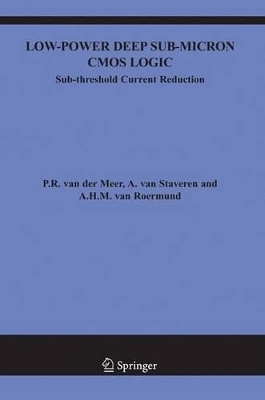
Low-Power Deep Sub-Micron CMOS Logic
Springer-Verlag New York Inc.
978-1-4020-2848-9 (ISBN)
- Titel z.Zt. nicht lieferbar
- Versandkostenfrei
- Auch auf Rechnung
- Artikel merken
1. Introduction.- 1.1 Power-dissipation trends in CMOS circuits.- 1.2 Overview of present power-reduction solutions.- 1.3 Aim and scope of this book.- 1.4 Organization of the book.- 2. Power Versus Energy.- 2.1 Power considerations.- 2.2 Energy considerations.- 2.3 Conclusions.- 3. Power Dissipation in Digital CMOS Circuits.- 3.1 Thermodynamics of computation.- 3.2 Functional power dissipation.- 3.3 Parasitical power dissipation.- 3.4 Trends in power dissipation.- 3.5 Conclusions.- 4. Reduction of Functional Power Dissipation.- 4.1 Node transition-cycle activity factor.- 4.2 Clock frequency.- 4.3 Transition-cycle energy.- 4.4 Conclusions.- 5. Reduction of Parasitical Power Dissipation.- 5.1 Leakage power dissipation.- 5.2 Short-circuit power dissipation.- 5.3 Need for weak-inversion current reduction.- 5.4 Conclusions.- 6. Weak-Inversion Current Reduction.- 6.1 Classification.- 6.2 Conclusions.- 7. Effectiveness of Weak-Inversion Current Reduction.- 7.1 General effectiveness.- 7.2 Technique-specific effectiveness.- 7.3 Conclusions.- 8. Triple-S Circuit Designs.- 8.1 Process flow.- 8.2 Experimental circuits.- 8.3 Leakage, speed, area and functional power.- 8.4 Practical applications and limitations.- 8.5 Conclusions.- 9. Conclusions.- 10. Summary.- References.
| Erscheint lt. Verlag | 4.8.2005 |
|---|---|
| Reihe/Serie | The Springer International Series in Engineering and Computer Science ; 841 |
| Zusatzinfo | 128 Illustrations, black and white; XIV, 154 p. 128 illus. With CD-ROM. |
| Verlagsort | New York, NY |
| Sprache | englisch |
| Maße | 160 x 240 mm |
| Themenwelt | Mathematik / Informatik ► Informatik ► Theorie / Studium |
| Technik ► Elektrotechnik / Energietechnik | |
| ISBN-10 | 1-4020-2848-2 / 1402028482 |
| ISBN-13 | 978-1-4020-2848-9 / 9781402028489 |
| Zustand | Neuware |
| Haben Sie eine Frage zum Produkt? |